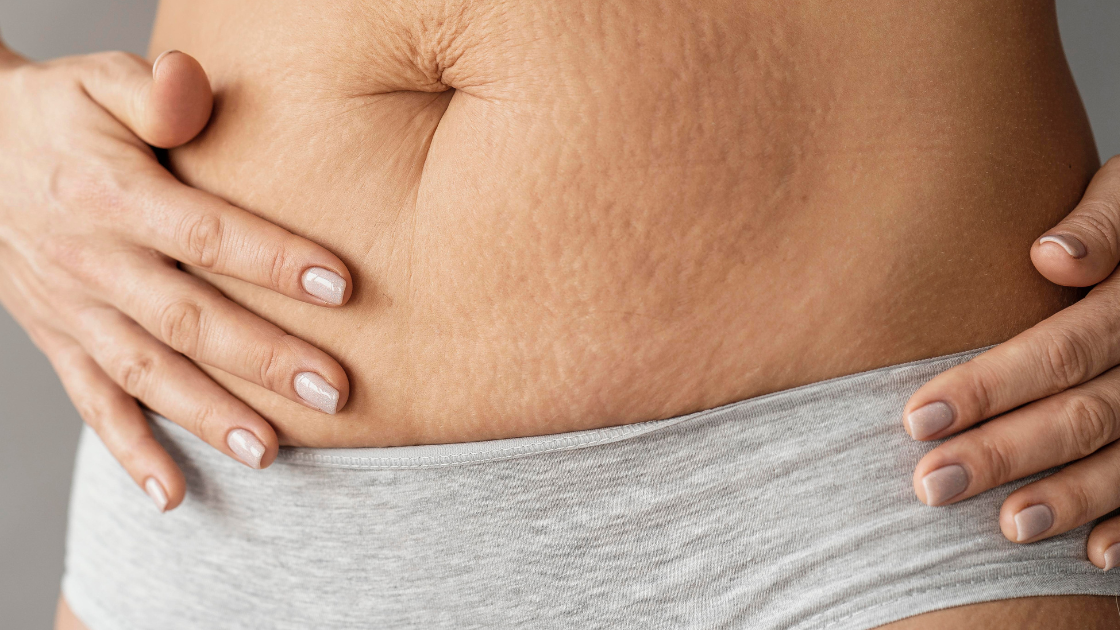My Cart(0)
Bellefit is an American apparel company manufacturing and selling women’s postpartum girdles, corsets, shapewear and other undergarments under the Bellefit® brand.
Understanding and Managing Stretch Marks

Stretch marks, those distinctive lines that often adorn our bodies, are a testament to the incredible journeys our bodies undergo. Whether from pregnancy, growth spurts, or changes in weight, these marks are a natural part of human life. Yet, despite their ubiquity, stretch marks can be a source of discomfort and insecurity for many. This post delves into the what, why, and how of stretch marks, drawing on insights from the Mayo Clinic, the American Academy of Dermatology (AAD), and the Cleveland Clinic, to provide a comprehensive guide to understanding, treating, and embracing your "tiger stripes."
What Are Stretch Marks?
Stretch marks, medically known as striae distensae, are a form of scarring on the skin with an off-color hue. They're caused by the tearing of the dermis during periods of rapid growth of the body or significant weight changes. These marks can cover large areas of the body and are not physically harmful but can cause issues with self-image and anxiety for some individuals.
Why Do They Appear?
According to the AAD, stretch marks appear when the skin is pulled by rapid growth or stretching. Although the skin is usually fairly elastic, when it's overstretched, the normal production of collagen (the major protein that makes up the connective tissue in your skin) is disrupted. As a result, scars in the form of stretch marks may form.
Factors that might increase your likelihood of getting stretch marks include:
- Family history: If your parents had stretch marks, you're more likely to have them too.
- Pregnancy: Most pregnant women will get stretch marks by the third trimester.
- Rapid weight gain or loss
- Rapid growth during puberty
- Certain medical conditions: Such as Marfan syndrome and Cushing's syndrome, can cause stretch marks by increasing the amount of cortisone in your body.
- Prolonged use of corticosteroid creams and lotions can decrease collagen levels in the skin, leading to stretch marks.
Managing and Treating Stretch Marks
While stretch marks are a natural part of many people's lives and journeys, understanding the desire to minimize their appearance is equally important. Here are some expert-backed approaches to managing and potentially reducing stretch marks:
-
Topical Treatments: The Mayo Clinic notes that tretinoin cream (Retin-A, Renova) derived from Vitamin A, can improve the appearance of recent stretch marks — those that are red or pink. This cream works by rebuilding collagen, making the stretch marks look more like your normal skin. However, tretinoin isn't recommended for use during pregnancy.
-
Light and Laser Therapies: Light and laser therapies stimulate the growth of collagen or elastin in your skin. Your doctor might use one of these treatments to reduce the appearance of stretch marks slightly.
-
Microdermabrasion: This involves a hand-held device that blows crystals onto the skin. These crystals gently abrade or "polish" the skin's surface. Then, a vacuum tube removes the crystals and skin cells. As your skin heals, it may appear smoother and less scarred by stretch marks.
-
Cosmetic Surgery: In some cases, cosmetic surgery, such as a tummy tuck, may remove skin with stretch marks. But these operations carry risks, are expensive, and are usually not recommended for purely cosmetic reasons.
Prevention and Self-Care
While not all stretch marks can be prevented, maintaining healthy skin can help reduce the risk of developing them. The Cleveland Clinic suggests maintaining a healthy weight and diet rich in vitamins and minerals, particularly vitamins A and C, zinc, and silicon, for skin health.
Hydration is also crucial. Well-hydrated skin is more pliable and may be less prone to stretch marks. Aim for at least 8 glasses of water a day to keep your skin hydrated from the inside out.
Embracing Your Skin
Beyond treatments and prevention strategies, an important aspect of dealing with stretch marks involves embracing them. These marks are symbols of growth, of life changes, and sometimes, of bringing new life into the world. They're part of your story and unique journey.
Social movements and initiatives across the internet have begun to challenge traditional beauty standards by encouraging men and women to embrace their stretch marks. By sharing stories and pictures, individuals worldwide are helping to normalize these natural marks and celebrate the beauty in the diversity of human bodies.
Conclusion
Stretch marks are a common, if sometimes unwelcome, part of our bodily history. While there are methods to manage and treat them, learning to love them as part of your unique story can also be a powerful act of self-acceptance. Whether you choose to minimize their appearance or wear them with pride, remember that your worth is not defined by the smoothness of your skin but by the depth of your humanity and the strength of your character.
Remember, each mark is a testament to a life lived, a challenge faced, or a change embraced. They are not flaws but rather symbols of resilience, growth, and sometimes, the creation of life itself. In embracing our "tiger stripes," we embrace the stories they tell and the strength they represent.
Cynthia Suarez
- Sep 03, 2024
- Category: News
unsubscribe at any time without costs.











